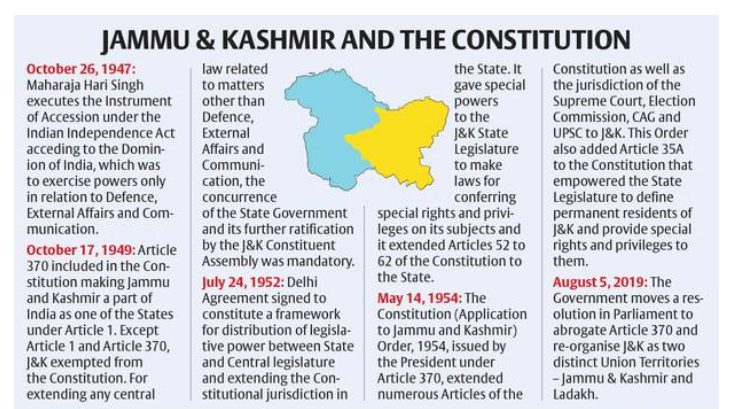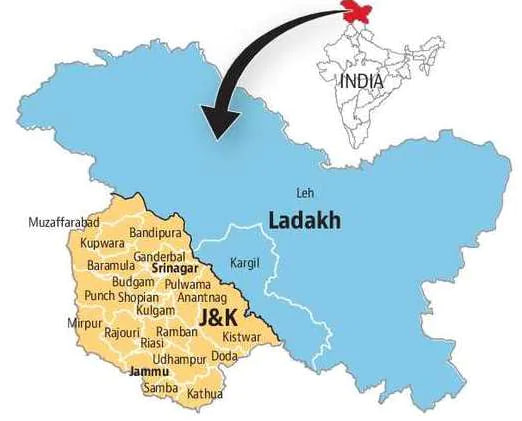



Copyright infringement not intended
Picture Courtesy: THE HINDU
Since reorganization as a Union Territory (UT) without a legislature in 2019, Ladakh has witnessed a unified political movement demanding greater autonomy. Recent protests, led by activist Sonam Wangchuk, have escalated tensions, stressing the urgent need for a balanced and sensitive resolution.
On August 5, 2019, the Union Government reorganized the former state of Jammu and Kashmir, carving out Ladakh as a separate Union Territory (UT).
This move fulfilled a long-standing aspiration, particularly among the Buddhist-majority population of Leh, who had historically demanded separation from the Kashmir-centric administration.
 Initial Divergent Reactions
Initial Divergent Reactions
Leh District: Celebrated the creation of the UT, viewing it as “freedom from Kashmir” and an opportunity for focused regional development.
Kargil District: The Muslim-majority district criticised the move as a betrayal, responding with protests, strikes, and a call for retention of ties with Jammu and Kashmir.
Shared Political Disillusionment
The early positiveness in Leh slowly faded as the realities of centralized administration under a Lieutenant Governor became evident. Both Leh and Kargil districts experienced:
Formation of Cross-District Alliances
Recognizing the need for unified representation, the Leh Apex Body (ABL) and the Kargil Democratic Alliance (KDA) presented a joint set of demands to the Central Government.
Full-Fledged Statehood
Ladakh seeks an elected legislative assembly and a state government to restore democratic law-making powers, filling the legislative vacuum left by the UT status without a legislature.
Inclusion under the Sixth Schedule (Article 244)
This is the core demand for constitutional protection, to create Autonomous District Councils (ADCs) to safeguard the land, culture, and rights of the region's over 97% tribal population.
Establishment of a Public Service Commission (PSC)
A dedicated, local recruitment body aims to tackle the severe youth unemployment crisis and ensure domicile-based job reservations.
Separate Parliamentary Seats
Creating two different Lok Sabha constituencies for Leh and Kargil districts to ensure more equitable and effective national representation for both districts.
 Arguments For Supporting Ladakh's Demand
Arguments For Supporting Ladakh's Demand
Political Autonomy
As a UT, Ladakh lacks a legislature, reduced from four MLAs and two MLCs in J&K to one MP. The weakened Ladakh Autonomous Hill Development Councils (LAHDCs) and centralized rule by the Lieutenant Governor promote alienation.
Statehood would restore legislative powers, while Sixth Schedule inclusion would empower local councils for decentralized governance.
Tribal Identity Protection
With 97% of its population as Scheduled Tribes, Ladakh stresses cultural and demographic dilution post the abrogation of Articles 370 and 35A. The Sixth Schedule would safeguard tribal customs and land rights.
Land and Resource Preservation
The fragile ecosystem faces threats from mining and unregulated tourism. Sixth Schedule councils could regulate land and forests, ensuring sustainability.
Economic Needs
According to the Periodic Labour Force Survey (PLFS) 2023-24 data, the overall unemployment rate for the region stood at 22.2%, with female unemployment soaring to 38.3%.
The unemployment rate among graduates in Ladakh is 26.5%, more than double the national average of 13.4%.
The absence of a dedicated PSC has hampered local recruitment, leaving thousands of government posts, including gazetted positions, unfilled since 2019.
Strategic Autonomy
Statehood and Sixth Schedule status would enable local governance while maintaining central control over security, promoting trust in a border region.
National Security Concern
Ladakh shares sensitive borders with China and Pakistan. The Centre views direct control through UT administration as essential for maintaining security, rapid military deployment, and seamless strategic infrastructure development.
Financial Non-Viability
Ladakh possesses a negligible internal tax base, making it almost entirely reliant on Central Government funding for administration and development.
Creating a full state machinery (legislature, bureaucracy, judiciary) for a population of only about 3 lakhs would impose substantial and administratively inefficient financial burdens.
Constitutional Hurdles of Sixth Schedule
The Sixth Schedule (Article 244) was explicitly designed for tribal areas in four Northeastern states (Assam, Meghalaya, Tripura, Mizoram). Extending it to Ladakh requires a constitutional amendment, which involves a complex legal and procedural process.
Strengthening LAHDCs
Instead of immediate statehood, the Centre could enhance the legislative, executive, and financial powers of the existing Ladakh Autonomous Hill Development Councils (LAHDCs). This approach utilizes existing institutions and provides a functional compromise.
Tailored Constitutional Safeguards
Government can implement "safeguards on the lines of the Sixth Schedule", by enacting a specific Act of Parliament or constitutional order under Article 240, tailored to Ladakh’s unique tribal and strategic context.
Institutionalized Dialogue
Creation of a permanent, high-level consultation forum involving the LAB, KDA, and the Ministry of Home Affairs would establish a transparent, sustained channel for conflict resolution and joint planning.
Financial Support
Increase central grants for infrastructure, education, and renewable energy, leveraging schemes like the Green Climate Fund.
Ladakh PSC
Establish a PSC to address unemployment through domicile-based recruitment.
Ecological and Cultural Safeguards
Adopt policies inspired by Bhutan’s Gross National Happiness to protect Ladakh’s heritage and ecosystem.
Ladakh’s statehood and Sixth Schedule demand arises from lost democratic safeguards post-2019, aiming to protect its tribal majority, land, and environment. Fulfilling this requires a constitutional amendment, balancing local autonomy with national security concern.
Source: THE HINDU
|
PRACTICE QUESTION Q. The democratic aspirations of a border region must be reconciled with its strategic imperatives. Critically Analyze. 250 words |
The main demands are full-fledged statehood with an elected legislative assembly, inclusion under the Sixth Schedule of the Constitution for tribal safeguards, the establishment of a dedicated Public Service Commission for job reservations, and two separate parliamentary seats for Leh and Kargil.
The government argues that the Sixth Schedule was designed for northeastern states and extending it to Ladakh would require a constitutional amendment. It also cites potential complexities for administration and security in the strategically sensitive border region.
Sonam Wangchuk is a prominent educationist and climate activist who has become a leading voice of the movement. He was on a hunger strike in September 2025 to press the demands for statehood and Sixth Schedule status, but was later arrested under the National Security Act following the violence.
© 2025 iasgyan. All right reserved